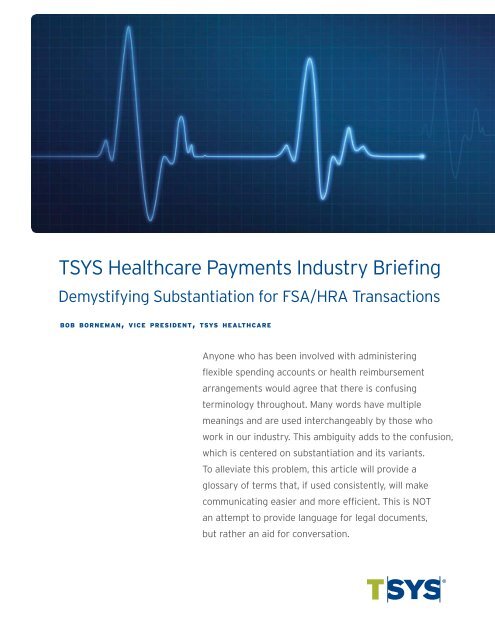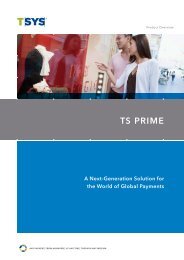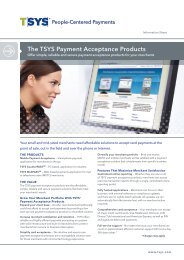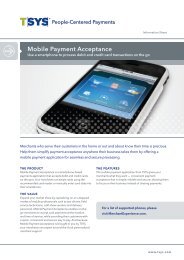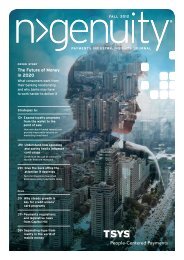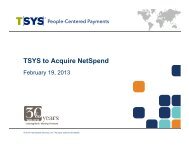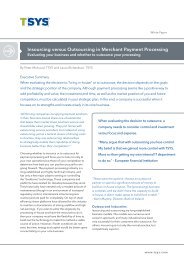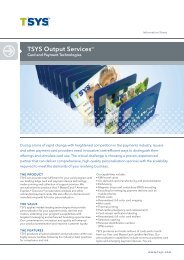TSYS Healthcare Payments Industry Briefing - PYMNTS.com
TSYS Healthcare Payments Industry Briefing - PYMNTS.com
TSYS Healthcare Payments Industry Briefing - PYMNTS.com
Create successful ePaper yourself
Turn your PDF publications into a flip-book with our unique Google optimized e-Paper software.
Few issuing processors support real-time co-pay substantiation, but<strong>TSYS</strong> <strong>Healthcare</strong> can approvebased on a co-pay amount and substantiatevia batch co-pay substantiation.supplies, etc. The negative side isthat since the authorization has beenapproved and money has been paidto the merchant, there is a chancethat at posting time the paymenttransaction will not match an entryin the co-pay table and will requirethe administrator to requestdocumentation from the employee,often referred to as ‘pay and chase’. ’This method provides for a bettercardholder experience but potentiallymore work for the administrator.Real Time Co-Pay Substantiation:Co-pay matching can occur during theauthorization. When the authorizationis received by the issuing processor, theco-pay table is accessed in real time,and the authorization decision includesthe amount, the MCC and the co-paytable. If a match is made, the authorizationis approved; if not, the authorizationis declined. The positive side of thisapproach is that it guarantees the administratorwill not ever have to ‘pay andchase’ for co-pay transactions. The negativeside is that for the cardholder, thecard can only be used to pay for co-payamounts at the doctor, dentist, pharmacy,etc. Since non-co-pay amounts will bedeclined, the employee will have topay for other services at the doctor’soffice and file a claim to be reimbursed,resulting in a negative experience forthe cardholder.For the most part, all issuing processorsprocessing FSA/HRA debit cards cansupport batch co-pay substantiation.Few issuing processors supportreal-time co-pay substantiation, but<strong>TSYS</strong> <strong>Healthcare</strong> can approve basedon a co-pay amount and substantiatevia batch co-pay substantiation, if bothoptions are set up similarly.Substantiation Look Back Period<strong>TSYS</strong> <strong>Healthcare</strong> has a unique substantiationmethod called ‘look back.’ This methodwas added to ac<strong>com</strong>modate the sort ofsituation where co-pay tables have beenset up on the system and are modifiedafter the plan year begins. When thishappens, it is possible that sometransactions that did not match theco-pay table before the change were notauto-substantiated. This process allowsfor the table to be changed, and thetransactions from up to 120 days priorcan be re-run against the updatedtable. This batch process will save theadministrator from having to manuallysubstantiate transactions that shouldhave been auto-substantiated withthe new tables.Recurring expense: Recurring expensessuch as orthodontic charges can beauto-substantiated by the issuingprocessor. A recurring expense requiresthat the authorization <strong>com</strong>e from thesame merchant for the same amountover a specified period of time. Theinitial transaction must be substantiatedby the administrator before subsequenttransactions can be auto-substantiatedby the issuing processor.For example, an authorization for $153 isreceived from MCC 8021 (orthodontist)and is manually substantiated by theadministrator. The administrator thensets up the transaction as a recurringexpense transaction with the issuingprocessor. The administrator alsoprovides an approximate end datefor the recurring expense. The nexttime an authorization for $153 isreceived from MCC 8021, it will be autosubstantiatedby the issuing processor.An authorization for $157 would beapproved, since it is from the MCC 8021,but it would not be auto-substantiatedbecause it does not adhere to theestablished recurring expense rule.IIAS: Inventory information approvalsystem (IIAS) is a system employedby the merchant to be identified by a4 | www.tsys.<strong>com</strong>
universal product code (UPC) in whichspecific merchandise qualifies for FSAand HRA reimbursement. A list of individualUPCs is maintained by the specialinterest group for IIAS standards (SIGIS).The merchants, who are members ofSIGIS, download the list at least monthlyto update their systems with the latestinformation. Debit cards registered withVisa or MasterCard are a restricted IIAStype card. When the card is used at themerchant, the card number is checkedto see if it has been registered as arestricted card. If it has, then the IIAS isused to total up the items that qualify asFSA/HRA reimbursable and those thatdo not. The authorization is sent to theissuing processor and contains the totalamount for the transaction, a subtotal foreligible items and an optional subtotal forprescription items. The issuing processorutilizes logic based on the total and thesubtotals to determine if the authorizationshould be approved or not.If the merchant supports what is knownas partial authorization, the issuingprocessor can approve just the eligibleitem subtotal and decline the rest of theauthorization. In this case, the merchantreceives a message at the terminalasking them to request another formof payment for the non-eligible items. Ifthe merchant does not support partialauthorization and the total transactionamount is different than the eligible itemsubtotal, the issuing processor mustdecline the entire transaction.The IIAS auto-substantiationprocess has dramatically improvedauto-substantiation rates for theadministrators of benefit plans. Itis possible for administrators to optout of the IIAS process, but virtuallyall of them elect to participate.Credit/debit matching: It is possiblefor the register operator to swipe thecard for the wrong amount, performa credit and re-swipe the card. Thiswould create a credit in the systemthat technically requires substantiationby the administrator. <strong>TSYS</strong> <strong>Healthcare</strong>has a process in place where debitsand credits that occur on the sameday at the same merchant for the sameamount are both auto-substantiated.Authorization amount matching: It ispossible to set up the <strong>TSYS</strong> <strong>Healthcare</strong>issuing processing system to screen fortransactions that match a list of exactamounts. This is similar to the real-timeco-pay matching mentioned earlier.This functionality is used by some planadministrators to administer HRA planswhere the employer is paying specificallyfor co-pays, prescription co-pays or otherspecific amounts.There also exists the ability to approvean amount within a range of amounts.For example, the system can be set up toapprove any amount between up to $100.This is also useful for HRA plans wherethe employer will pay up to a certainamount at certain merchants.PBM: Some pharmacy benefit management<strong>com</strong>panies can provide data toissuing processors or plan administratorsto use for the substantiation of prescriptiontransactions. This was the methodused for prescriptions before IIAS wasestablished. This method was availablein two models: a real-time version and abatch version at posting time. The realtimeversion included the ability for theissuing processor to access the PBM dataduring the authorization to determine thepatient responsibility amount and makean approve-or-decline decision at thepoint of sale. The batch version hadsimilar logic, but occurred at postingtime, and allowed for the card to beused for general FSA/HRA use. Thereal-time version limited the card use towww.tsys.<strong>com</strong> | 5
Thoughtful solutions provide sound levels in the 80-percentrange of auto-substantiation for the administrator andincreased consumer adoptionof benefits payment cards because they are convenient and easy to use.Some Definitions:Substantiation: Documentation provided by the employeewho has performed a transaction or presented a claim forreimbursement from the FSA or HRA account. The documentationcan take many forms, including paper receipts, letters fromphysicians or dentists, prescriptions or other third-party sources.For debit card transactions, substantiation data may <strong>com</strong>e fromthe issuing processor, a pharmacy or the merchant.Auto-substantiation: Auto-substantiation is the process ofobtaining substantiation without human intervention. Autosubstantiationdata is received in electronic format from a thirdparty or the issuing processor of the debit card. The data ismatched to the transaction or claim in the administrator’ssoftware system and is automatically substantiated.Adjudication: The process of receiving a claim from a providerand determining the amount of the payer’s financial responsibility(payment) after the member’s insurance benefit allowance hasbeen applied to the claim. This approves a transaction or claimas an allowable or valid FSA HRA expenditure. The process ofadjudication includes substantiating the transaction.Pay and Chase: Is the mechanism that allows the approvaland payment for a service, that does not substantiate, andrequires the administrator to request a receipt associated tothe payment in order to verify validity. If the service is deemedvalid for the payment, the activity is manually substantiated.If the service is not valid the consumer is responsible forrepaying the amount for that transaction.Debit Card: A plastic card issued by a bank for use in FSA/HRA/HSA benefit plans, which is made available to employees by thebenefit plan administrator. Employees and their family membersuse the card to access their benefit funds directly without havingto file a claim. The debit card transaction be<strong>com</strong>es the claimin the administrator system.Issuing Processor: The issuing processor is an entity that isconnected to one or more card networks (e.g. Visa, MasterCard)and has the logic to correctly authorize payments from the debitcards. Administrators work with the issuing processor to providethe authorization rules for individual employer benefit plans. Anexample of an issuing processor is <strong>TSYS</strong> <strong>Healthcare</strong>.Authorization Response: The authorization response is amessage sent back to the merchant from the issuing processoreither approving or declining a request for payment from thedebit card account. If an authorization is approved, the availablebalance on the card is reduced immediately. If declined, thebalance is not changed. Some forms of substantiation alsooccur at authorization time.Posting: Posting is the nightly process whereby all clearedtransactions supplied by the association are applied to the actualbalance of the debit card accounts. Some forms of substantiationalso occur at posting time.Merchant Category Code (MCC): Every merchant that processesany kind of card transaction is assigned an MCC. All merchants areplaced into categories. For example, all pharmacies have the MCC of‘5912.’ The MCC is included in the authorization message from themerchant terminal and is used by the issuing processor as part ofthe logic in determining whether or not an authorization should beapproved or declined.Merchant ID: The Merchant ID (MID) is a code assigned to eachmerchant. It is more specific than the MCC as it identifies thespecific merchant. For example, Walgreens will have an MCC of‘5912’ because it is a pharmacy, but it will have a separate merchantID ‘xxxxxxxxxxxx’ to identify that it is specifically Walgreens.Special Interest Group for IIAS Standards (SIGIS): This isan industry organization responsible for providing guidelines forIIAS transaction utilization, and for maintaining the 90 percentpharmacy list. Find out more at www.sig-is.org.www.tsys.<strong>com</strong> | 7


